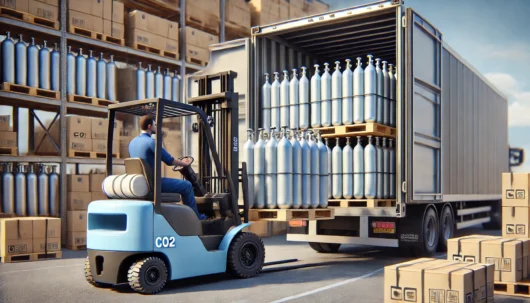In the realm of food preservation and quality maintenance, food-grade gases have become a pivotal element. These gases, such as nitrogen, carbon dioxide, and oxygen, are instrumental in various stages of production and storage, helping to extend shelf life and maintain the desired qualities of food products. Moreover, innovations in food grade gas applications, production, mixture, and delivery have allowed producers to refine applications and tailor solutions to specific needs.
Understanding the advancements in food-grade gas technologies is essential for professionals in the food industry. It lets you make informed decisions about investing in equipment and processes that effectively leverage these gases. On-site gas generation systems, such as the innovations by Airgas and food-grade gas applications developed by Linde Gas, are examples of progressive advancements that ensure both cost-effectiveness and high-quality results.
Key Takeaways
- Food-grade gases play a crucial role in preserving and maintaining the quality of food products.
- Technological advancements have optimized the use of these gases in the food industry.
- Equipment for on-site gas generation can be a cost-effective solution for your needs.
Innovations in Food Grade Gas Production and Technology

Recent advances in the food industry have revolutionized how you can use food-grade gases, emphasizing enhanced food processing, storage, and safety.
Advancements in Gaseous Applications for Food Processing
You’ll find that oxygen, carbon dioxide, and nitrogen are pivotal in food preservation and packaging. High-pressure applications have led to the creation of modified atmosphere packaging (MAP), significantly extending fresh produce’s shelf life. Thanks to new gas mixtures, the technology also includes fine-tuning the gaseous environment around the food. For instance, Linde has developed advanced gas technology that allows for precision control over mix ratios, providing fresh produce with the exact environmental conditions needed to maintain quality.
Development of Gas Mixtures and Storage Solutions
The production of liquid carbon dioxide (LIC) and nitrogen in forms suitable for the food industry has seen considerable innovation. With precise energy control in mind, gas mixtures are now custom-designed to meet specific food preservation needs. As for storage, technological advancements ensure that these gases are maintained under optimal conditions until use. Moreover, new storage solutions, capable of holding gases in various states, from high-pressure cylinders for gas-based mixtures to cryogenic tanks for LIC, help maintain the integrity of the gases. Modern technological improvements have significantly enhanced your ability to rely on these developments for consistently safe and quality food products.
Impact of Food Grade Gases on Quality and Preservation

Food-grade gases such as carbon dioxide and nitrogen enhance food products’ shelf life and quality. Understanding their applications can advance food preservation techniques and ensure adherence to safety standards.
Enhanced Preservation Techniques
Food-grade gases like nitrogen and carbon dioxide are pivotal in Modified Atmosphere Packaging (MAP), changing the atmospheric composition within food packaging. You leverage these gases to customize atmospheres that significantly extend the shelf life of perishable items like meat and fish by slowing down microbial growth and oxidative reactions. Chilling and freezing with dry ice (solid carbon dioxide) are other innovative applications you use to preserve food quality and freshness during transport.
- Nitrogen: Prevents oxidation and maintains freshness.
- Carbon Dioxide: Inhibits microbial growth and is used in carbonating beverages.
Quality Control and Safety Standards in Food Packaging
Quality control and food safety are your top priorities regarding food packaging. You implement traceability systems and compliance with regulations to ensure that every product meets the highest standards. Utilizing equipment designed for food-grade gas application, such as delivery systems for liquid carbon dioxide and cryogenic chilling, allows for precise food quality management throughout the food processing journey.
- Food Safety: You ensure rigorous testing and monitoring for compliance with safety standards.
- Traceability: You maintain detailed records of food products’ origin, treatment, and storage conditions.
Frequently Asked Questions
Innovations in food-grade gas applications have led to safer and more efficient preservation techniques that extend shelf life and maintain food quality. Moreover, these advancements have become a crucial part of the food industry from technologies that guarantee purity to market expansions reflecting growing demand.
How are different types of gases utilized in food preservation and packaging?
Your food is often kept fresh with nitrogen, oxygen, and carbon dioxide. These gases are chosen for their properties; for instance, nitrogen is an inert gas that displaces oxygen and is used in packaging to delay spoilage and prevent oxidation.
What technological advancements are enhancing the safety and efficiency of food-grade gas usage?
Recent advancements include sophisticated monitoring systems that ensure the correct mix and levels of gases within the packaging. This technology maintains food safety and prolongs shelf life by helping to prevent the growth of aerobic bacteria and other pathogens.
What is the current market size and growth projection for food-grade gases?
Food-grade gases are expanding as demand for packaged and convenience foods increases. A growing emphasis on food safety and quality is also characterizing the sector, driving investments and adoption.
How does carbon dioxide application benefit food processing and storage?
Carbon dioxide is used in chilling and freezing, which is crucial for preserving food quality. It is also used for carbonation in beverages, giving your sodas and sparkling waters that distinctive fizzy taste.
What are the regulatory standards governing the use of food-grade gases?
Strict regulatory standards such as the Food Safety Modernization Act govern the use of food-grade gases. These standards ensure that the gases used are of a high purity level and are safe for consumption.
How has adopting food-grade gases impacted the shelf life and quality of food products?
The use of food-grade gases in packaging has significantly increased the shelf life of many products, maintaining their appearance, taste, and nutritional value for extended periods, reducing waste, and improving food distribution efficiency.
expertmixologist
+356 7939 8622


